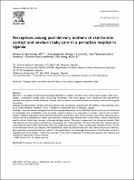| dc.contributor.author | Byaruhanga, Romano | |
| dc.contributor.author | Bergstro¨m, Anna | |
| dc.contributor.author | Tibemanya, Jude | |
| dc.contributor.author | Nakitto, Christine | |
| dc.contributor.author | Okong, Pius | |
| dc.date.accessioned | 2021-04-15T14:59:10Z | |
| dc.date.available | 2021-04-15T14:59:10Z | |
| dc.date.issued | 2006-09-06 | |
| dc.identifier.citation | Byaruhanga, R.N., Bergström, A., Tibemanya, J., Nakitto, C. and Okong, P., 2007. Perceptions among post-delivery mothers of skin-to-skin contact and newborn baby care in a periurban hospital in Uganda. Midwifery, 24(2), pp.183-189. | en_US |
| dc.identifier.issn | 0266-6138 | |
| dc.identifier.uri | https://doi.org/10.1016/j.midw.2006.09.002 | |
| dc.identifier.uri | http://hdl.handle.net/20.500.12280/2654 | |
| dc.description.abstract | Objective: to explore the perceptions among post-delivery mothers of skin-to-skin contact and newborn baby care.
Design: a qualitative design using focus-group discussions. Five focus groups were conducted with post-delivery
mothers who had had normal deliveries. A latent content analysis was used to derive the themes from the focus-group discussions.
Settings and participants: 30 post-delivery mothers were purposively sampled from 249 mothers in the postnatal ward
at St Francis Hospital, Nsambya, which is located in a periurban area in Kampala, Uganda.
Findings: two main themes emerged from the focus-group discussions: ‘acceptability of health practices are influenced
by knowledge and sensitisation’ and ‘pregnant women’s choices are dependent on social, cultural and economic
factors’. Mothers expressed varying opinions about the usefulness of skin-to-skin contact: some knew about its use to
reduce the risk of hypothermia; others were ignorant, whereas some believed skin-to-skin contact was an intervention
used to distract them from the pain in the post-delivery period. The vernix caseosa and the mixture of amniotic fluid
with blood in the post-delivery period were perceived as dirty and infectious. The best informants for helping mothers
understand the skin-to-skin intervention were the health-care providers. Social, cultural and economic factors, as well
as the dominant role of the husband, were identified as important determinants for their choice and place of delivery.
Key conclusions and implications for practice: the gap between the knowledge and practice of skin-to-skin contact in
hospital needs to be bridged. Health-care providers need to be encouraged to continuously advocate for, educate and
implement regular skin-to-skin contact. | en_US |
| dc.language.iso | en | en_US |
| dc.publisher | Elsevier | en_US |
| dc.relation.ispartofseries | Midwifery;24(2) | |
| dc.subject | Perceptions | en_US |
| dc.subject | Skin to skin | en_US |
| dc.subject | Hypothermia | en_US |
| dc.subject | Uganda | en_US |
| dc.title | Perceptions Among Post-delivery Mothers of Skin-to-Skin Contact and Newborn Baby Care in a Periurban Hospital in Uganda | en_US |
| dc.type | Article | en_US |


